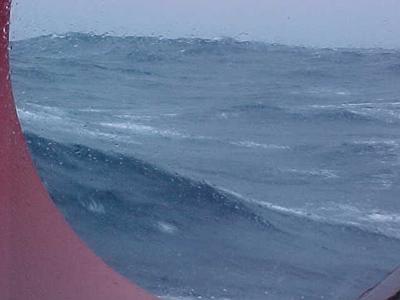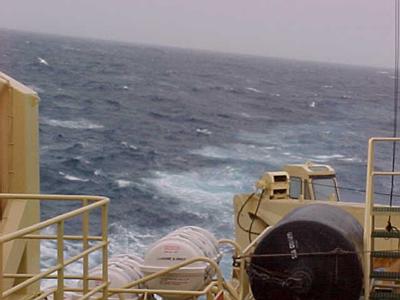
|
|
6 March, 2000
Drake Passage; Southern Ocean and Antarctic Convergence
Question 16: How large is a Wandering Albatross?
Yesterday we entered the Drake Passage. Late this evening, we crossed over
the Antarctic convergence. We are now in the Southern Ocean. The ocean was
given that name officially only a year or so ago, but the term has been in use
since the 1700s. After a search of nearly a million scientific references,
the name "Southern Ocean" was found to outnumber "Antarctic Ocean" by a ratio
of approximately 25:1.
The convergence is where the colder, less salty surface water from the south
meets the warmer, more salty water from the north (from the Atlantic, Pacific,
and Indian Oceans). The southern and northern waters mix in this zone, sink
and slide slowly north, beneath the surface layer. The convergence circles
Antarctica in an irregular pattern, generally around 50 degrees south
latitude; but its location is not fixed and it varies widely with the season,
the weather and the longitude. On our route south it occurs less than halfway
between Cape Horn and the tip of the Antarctic Peninsula. South of the
convergence the surface water temperature drops to just above zero degrees
centigrade. The air temperature outside should be noticeably cooler. There
are Wandering Albatross outside, gliding behind the ship. Also Cape or
Pintado Petrels fluttering around the water surface. There should be many
other types of pelagic seabirds in this area, but I have not spent enough time
standing up to find them.
The crew tells me that the seas are "normal" for this location but the ship
is definitely rocking a lot. The higher you are on the ship, the more you
feel the side to side motion, and the further away from the center of the ship
you are, the more you feel the forward and back plunge. Since my room is on
the 02 level, the side to side motion is really obvious. Everyone needs the
handholds in the hallways and stairways now. We move in a series of
controlled leaps, timing a rush to coincide with the direction of the ship's
movement and making sure there is something to hold onto or collapse into at
the end. On the stairs it is especially important to hang on. They are steep
stairs, and the strong springs on the doors make it impossible to open them if
the ship's tilt is against you. Even using the railings, taking a shower is
an experience. If you are fortunate, your shower is oriented so you merely
bash from wall to wall; if you are not, you bash against the back wall and
then come flying out of the shower.
Almost everyone is still up and around, although many fewer are focused on
work. The couches in the lounge are filled with bodies taking their minds off
the movement by watching yet another movie. No one tries to look out of the
port holes for very long, and one of the main conversation topics is the
different ways to wedge yourself into bed so you can get a good night's sleep.
Some favor lying spread out as flat as possible and pushing feet and elbows
into the sides of the bunk; some pack themselves in place with life vests,
extra clothes and immersion suits; others swear by stuffing hands and arms
under the mattress. Whatever the method, you still lurch from side to side as
you sleep, and our passage is not long enough for us to get fully acclimated
to it.
Answer 15: The Antarctic Convergence.

Cape Petrel.

View of waves out the galley porthole (a mate estimated that they were 10-15 ft).

Ship hallway.

View off stern of the Gould.

Contact the TEA in the field at
.
If you cannot connect through your browser, copy the
TEA's e-mail address in the "To:" line of
your favorite e-mail package.
|
